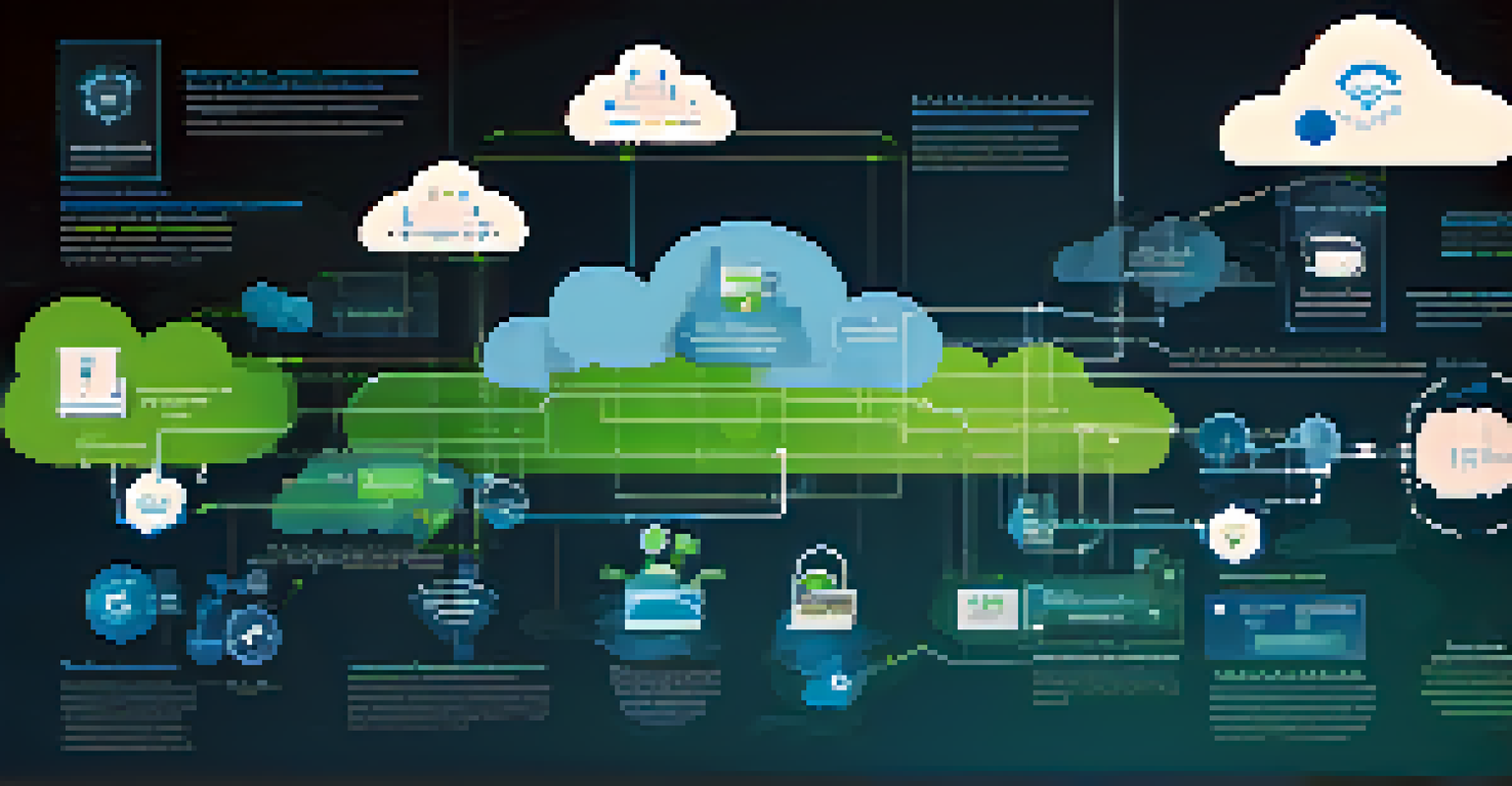Monitoring and Logging for Cloud Security Compliance

Understanding Cloud Security Compliance Requirements
Cloud security compliance refers to the adherence to regulations and standards that protect sensitive data in cloud environments. Common frameworks include GDPR, HIPAA, and PCI DSS. These regulations demand that organizations implement stringent measures to ensure data integrity and confidentiality.
Security is not a product, but a process.
Understanding these requirements is the first step toward achieving compliance. For instance, GDPR emphasizes the importance of data protection, which means organizations need to monitor how data is accessed and used. Failing to comply can result in hefty fines and damage to your reputation.
Moreover, each industry may have specific guidelines that dictate how data should be handled in the cloud. By familiarizing yourself with these regulations, you can tailor your monitoring and logging strategies to better meet compliance demands.
The Role of Monitoring in Cloud Security
Monitoring is like having a security guard for your cloud environment, constantly overseeing activities to detect any unusual behavior. It involves tracking user activity, data access, and system performance. This vigilance helps identify potential security threats before they escalate into serious breaches.

For example, if an unauthorized user tries to access sensitive information, a robust monitoring system will trigger alerts, allowing your team to respond quickly. This proactive approach not only helps in mitigating risks but also plays a crucial role in maintaining compliance.
Importance of Cloud Compliance
Adhering to regulations like GDPR and HIPAA is crucial for protecting sensitive data and avoiding severe penalties.
Additionally, continuous monitoring provides valuable insights into your cloud infrastructure's health, helping you optimize performance and resource allocation. It becomes easier to spot trends and anomalies, enabling your organization to make informed decisions.
Logging: Capturing Critical Data for Compliance
Logging involves the systematic collection and storage of data related to user activities and system events. Think of logs as the detailed diary of your cloud environment, recording every action that takes place. This information is vital for audits and compliance checks, as it provides a clear trail of who did what and when.
In the face of a changing world, organizations must continuously adapt their compliance strategies to protect sensitive data.
For instance, if a data breach occurs, logs can help you trace back the events leading up to the incident. This not only aids in remediation but also demonstrates your organization's commitment to compliance and security. It's like having a black box in an airplane that helps investigators understand what went wrong.
Furthermore, logs can be analyzed for patterns that might indicate security vulnerabilities. Regularly reviewing these logs allows organizations to stay ahead of potential threats, ensuring they maintain compliance with industry standards.
Integrating Monitoring and Logging Solutions
To effectively manage cloud security compliance, integrating monitoring and logging solutions is essential. These tools should work in tandem, providing a comprehensive view of your cloud environment. This integration allows for real-time analysis and alerts, making it easier to respond to threats promptly.
For example, a combined system could automatically log an incident when monitoring detects unusual activity. This streamlined approach not only saves time but also enhances your overall security posture. It’s like having a well-oiled machine where every part works together seamlessly.
Role of Monitoring and Logging
Integrating monitoring and logging systems is essential for real-time threat detection and compliance tracking.
Moreover, many cloud service providers offer native tools that can be integrated with third-party solutions for enhanced functionality. By leveraging these tools, organizations can create a robust monitoring and logging framework tailored to their specific needs.
Setting Up Alerts for Anomalies and Compliance Violations
Establishing alerts for specific anomalies is crucial in maintaining cloud security compliance. These alerts act as an early warning system, notifying your team of potential issues before they escalate. By fine-tuning what triggers an alert, organizations can avoid alert fatigue while ensuring real threats are addressed promptly.
For instance, unusual login attempts or access from unfamiliar IP addresses should trigger immediate alerts. This allows your security team to investigate and respond quickly, potentially preventing a data breach. It's like having a smoke detector that alerts you before a fire spreads.
Furthermore, alerts can also be set up for compliance violations, such as unauthorized access to sensitive data. By proactively monitoring for these violations, organizations can take corrective actions and maintain compliance with regulatory standards.
Conducting Regular Audits and Assessments
Regular audits and assessments are essential to ensure that your monitoring and logging practices are effective. These evaluations help identify gaps in security measures and compliance adherence. Think of audits as routine check-ups for your cloud environment, ensuring everything is functioning as it should.
During an audit, it’s important to review both monitoring and logging processes to ensure they are aligned with current compliance requirements. This not only helps in identifying potential issues but also aids in enhancing your overall security strategy. It’s a proactive way to stay ahead of regulations.
Training for Compliance Success
Regular training and awareness initiatives empower employees to understand and uphold cloud security compliance best practices.
Moreover, conducting assessments helps your organization adapt to new threats and changing compliance landscapes. By staying vigilant, you can continuously improve your security measures, reinforcing your commitment to protecting sensitive data.
Training and Awareness for Compliance Best Practices
Training your team on cloud security compliance best practices is vital for a successful monitoring and logging strategy. Awareness is the first line of defense; when employees understand the importance of compliance, they are more likely to follow established protocols. This collective effort strengthens your organization’s security posture.
Consider providing regular training sessions that cover the latest compliance regulations and the role of monitoring and logging. Engaging employees through workshops and simulations can make learning interactive and memorable. It's like teaching a fire drill—everyone needs to know what to do in case of an emergency.

Additionally, fostering a culture of security within your organization encourages team members to take ownership of compliance responsibilities. When everyone is on board, achieving and maintaining cloud security compliance becomes a shared goal, rather than just a box to check.